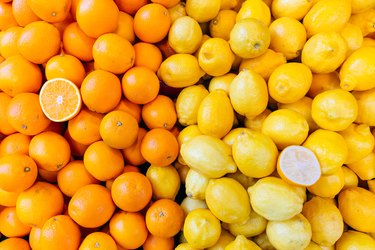
The sweet scent of citrus flowers and the sounds of buzzing bees fill the air in backyard orchards in U.S. Department of Agriculture plant hardiness zones 9 through 11. While the sweet orange (Citrus sinensis), sour orange (Citrus aurantium) and lemon (Citrus limon) are all members of the citrus family, there is a distinct difference between lemon and orange fruits and the size of the trees.
About Citrus Trees
Video of the Day
Natives of Asia, citrus trees prefer the long, warm summers and mild winters of Mediterranean climates. Orange trees need the hot days of summer for the fruits to sweeten, while lemon trees tolerate cooler summer temperatures, making them a better choice for coastal locations. In general, young citrus trees need protection from frosts and freezing temperatures as well as the hottest summer days. Mature trees can tolerate short periods in temperatures as low as 28 degrees Fahrenheit and up to 100-degree days in summer.
Video of the Day
Both orange and lemon trees thrive in backyard gardens, preferably on a sunny, south-facing slope where the soil is well-drained. In colder climates, grow lemon trees in 10- to 15-gallon containers and orange trees in 20- to-25-gallon containers. Take the trees indoors to a warm sunroom or greenhouse when temperatures drop into the mid-40s. Water regularly during dry periods and fertilize in spring with a slow-release fertilizer.
Prune lightly to shape and maintain the tree's size. Remove broken or diseased branches and water sprouts to enhance health and air circulation through the tree. While care is generally similar, the primary difference between the lemon tree and orange tree is the color, size and sweetness of the fruits.
Orange Tree Species and Cultivars
Sweet oranges include the popular navel oranges, which grow up to 30 feet tall and equally wide depending on the cultivar. 'Washington' and the pink-fleshed 'Cara Cara' oranges are seedless and easy to peel. 'Valencia' is a little tangier than the navel cultivars and is juicy and nearly seedless with a thin rind. These sweet fruits are enjoyed fresh or are squeezed for juice.
Blood oranges are also sweet oranges that feature red-orange flesh with hints of raspberry or strawberry infused with the sweet orange flavor. 'Moro,' 'Sanguinetii' and 'Tarocco' are the main cultivars found in the United States.
Less common in backyard gardens, sour orange trees tolerate a higher water table than the sweet species. The rinds of the tart fruits are used for marmalade and candying, and the juice flavors fish or is sweetened and enjoyed as a cold beverage. Sour orange trees are also used as rootstock for the sweet cultivars. If growth appears below the graft, remove it immediately or it will overtake the tree to produce thorns and sour oranges.
Lemon Tree Cultivars
'Eureka,' 'Lisbon' and 'Variegated Pink Eureka' are among the true lemon cultivars. 'Variegated Pink Eureka,' also known as 'Pink Lemonade,' is a sport of the 'Eureka' and produces variegated green and white foliage. The nearly seedless, green-striped fruits turn yellow with pink flesh when ripe. The parent tree, 'Eureka,' also has few seeds, but the fruits are more acidic. Both 'Eureka' and 'Variegated Pink Eureka' grow up to 20 feet tall in the garden.
'Lisbon' is the largest of the true lemons, growing 15 to 30 feet tall and equally wide. When grafted to dwarfing rootstock, it generally stays under 8 feet tall, which is small enough to grow in a container. This thorny tree produces bright yellow, acidic fruits.
Meyer Lemon Trees
The 'Improved Meyer' lemon tree (Citrus x meyeri) is a lemon-orange hybrid, possibly a mandarin orange (Citrus reticulata). Nearly thornless and naturally small, this tree is easily grown in containers on the patio and indoors. The lemons are juicy and sweet-tart without the acidic bite of the true lemons. In the warmest climate zones and indoors, Meyer lemons often bloom and produce fruit year-round.